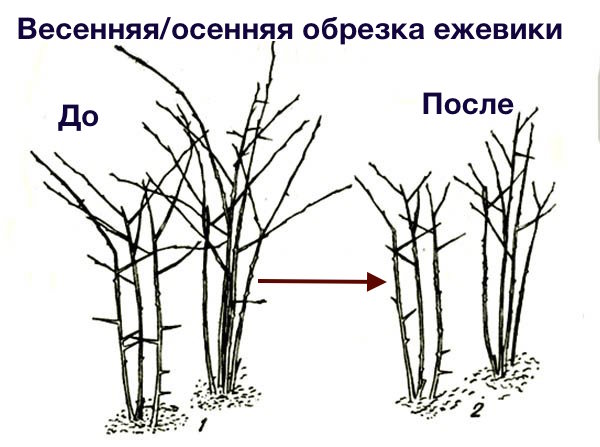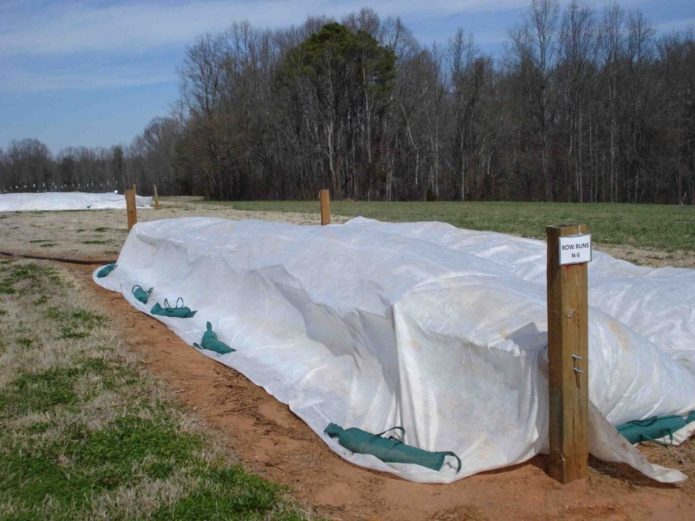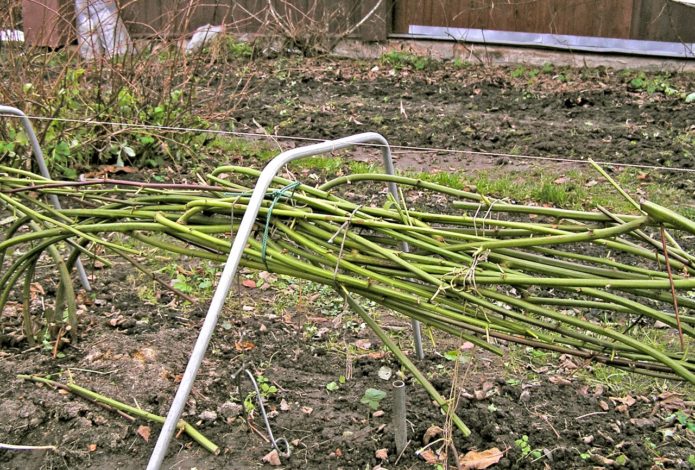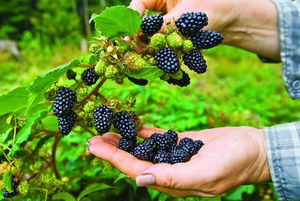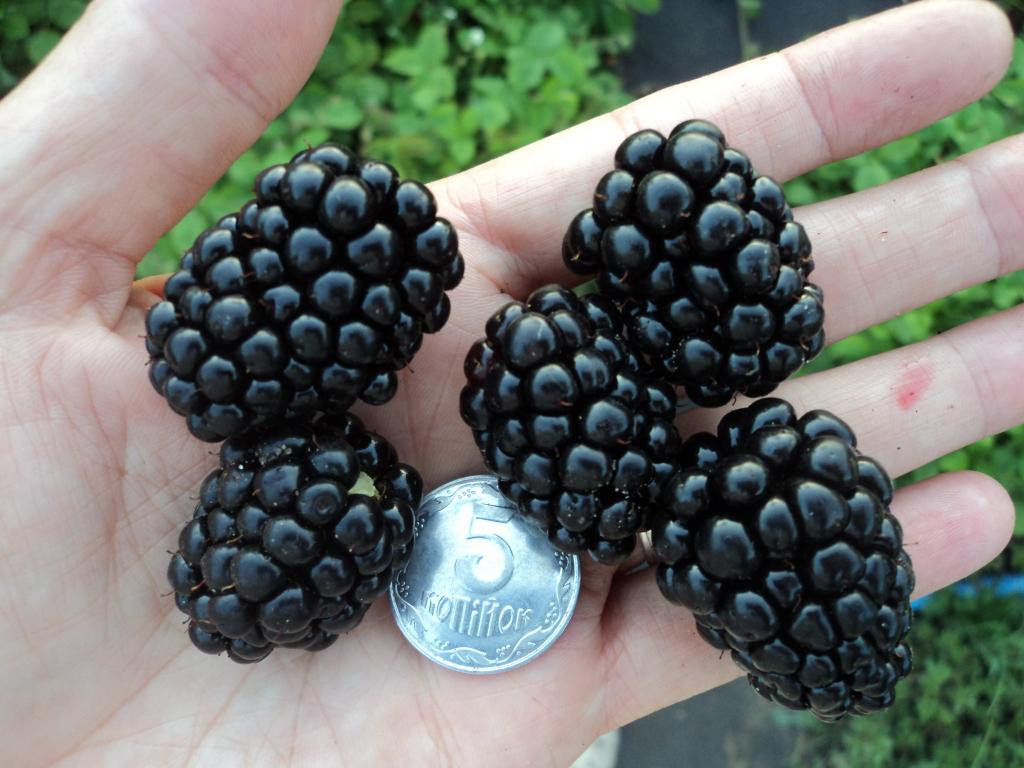The climatic conditions of most Russian regions do not allow the incredibly healthy and tasty blackberries to be grown on an industrial scale, as is done in many US states. The quality and taste of its berries were appreciated by amateur gardeners who began to plant shrubs in their own summer cottages. This culture needs constant proper care, and in the fall - preparation for winter.
Content
Preparing garden blackberries for wintering
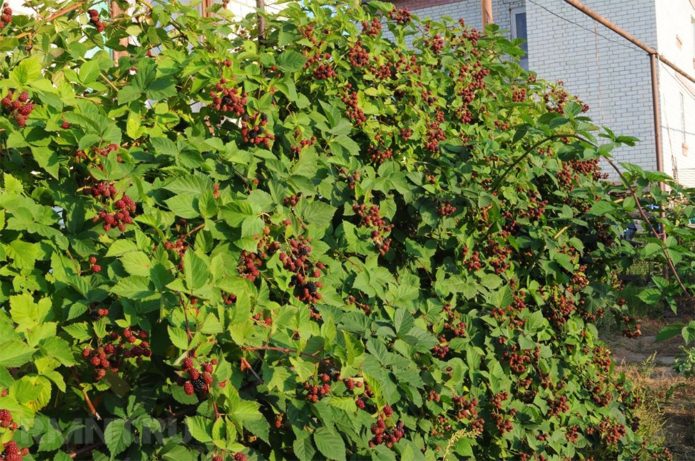
In order for shrubs to give a good harvest, you need to take care of them from the very beginning of the growing season.
Many gardeners believe that preparing a shrub for winter is only about creating a shelter that protects the blackberry from frost. However, this does not guarantee a good berry harvest in the next season. For a plant to survive the winter painlessly, it must be healthy and well-groomed.
When growing blackberries, the interlacing of individual bushes should not be allowed. The thickening of the plantings not only makes it difficult to care for the shrub, but also degrades the quality of the berries.
During the entire vegetative period, the shrub requires:
- systematic watering;
- pruning young branches;
- removing weeds around and under bushes;
- applying liquid fertilizers to the soil;
- support devices for shoots.
At a distance of at least two meters from each other, supports made of pillars are installed, between which horizontal rows of wire are pulled. You can also use a sturdy cord. The branches of the bush are neatly tied to the wire.
With the help of trellises, you can not only support the branches, but also form a bush, dividing its shoots into fruiting and growing ones. To do this, when tying them, they are tilted in different directions, which facilitates the autumn care of the bush.
After harvesting, the autumn stage of preparing the plant for wintering begins. The exact date for starting this work depends on both the climate in the region and the type of shrub. In early varieties, berry picking starts in mid-August, so maintenance work before winter usually begins in September.
If the owner of the site grows late-ripening varieties, the last harvest from which ripens in September, then caring for blackberries and they prepare it for the cold in October. Before covering the blackberry with an insulating material, work must be performed that creates favorable conditions for the shrub for wintering:
- with a prolonged absence of precipitation, the roots of the plant must be watered, but waterlogging of the soil must not be allowed;
- remove the branches on which the berries grew - next year these shoots will not bear fruit;
- cut off excess young branches;
- when growing creeping blackberries, remove the left shoots from the supports and carefully fold;
- feed the shrub.
Phosphorus and potash fertilizers are used as autumn feeding at the rate of 50-60 g per sq. meter. An excellent result is given by the addition of mineral fertilizers with organic matter. For soil of average fertility on an area of 1 sq. meter use a mixture consisting of 3-4 kg of organic fertilizer (peat or rotted manure), potassium salt (20 g) and superphosphate (30 g).
Many gardeners prefer wood ash. It is enough to add 1 glass of fertilizer under the bush for digging.You can also use ash for irrigation by infusing a glass of raw materials for several hours in 10 liters of water.
Blackberries need regular pruning of bushes, which will help not only create a decorative appearance of the plant, but also improve its yield:https://flowers.bigbadmole.com/en/yagody/obrezka-ezheviki-kogda-i-kak-pravilno-ee-delat.html
Features of autumn pruning
Blackberries need pruning twice a year. During the spring procedure, the bush is cleared of branches frozen and rotted during the winter, thanks to which it receives more nutrients, increasing its productivity. In the fall, pruning is done to strengthen the plant and improve its frost resistance.
Novice gardeners do not always know how to properly handle blackberries before wintering. In order not to damage the bush with your actions, you should determine the most favorable number of shoots left. In a healthy, medium-sized shrub, the root system is capable of providing food for a maximum of eight branches.
After pruning the damaged and old branches, eight to ten young branches are left, taking into account the possible death of several during the winter.
Effective fall pruning should be done with the following rules in mind:
- Biennial branches are removed immediately after harvest. In order to avoid the appearance of rot on the stumps, which can spread throughout the plant, the shoots must be cut off completely, to the very root.
- Poorly developed and weak young branches are also removed.
- Do not leave branches affected by insects.
- To ensure active flowering of the shrub after wintering, young shoots are cut to one fourth of their length.
After pruning, the removed branches should be removed and the soil around the shrub should be cleared of leaves. In order to avoid the reproduction of pests and diseases inherent in berry bushes, all garbage must be moved away from plantings and burned. The cleaned soil around the bushes must be sprinkled with plenty of peat or sawdust. They will retain moisture in the soil and protect it from excessive freezing.
Secrets of planting and transplanting blackberries:https://flowers.bigbadmole.com/en/yagody/posadka-ezheviki-vesnoy.html
The right winter shelter
After carrying out all the activities for the preliminary preparation of the blackberry for the winter, you can proceed to the shelter. You should not do this work before the onset of frost, since condensation forms under the influence of heat under the material, and in the absence of ventilation, excess moisture will contribute to the rotting of the plant. For this reason, the best time for a blackberry shelter is to lower the temperature to minus 5 °.
Cut off shoots must be bent to the ground as low as possible. If the plantings consist of creeping shrub varieties, this is easy to do. Shoots are removed from the supports and carefully laid on the ground.
For better preservation of the shoots, it is better to lay them on sawdust or on a wooden floor.
Erect varieties are prepared for shelter in advance by tying a small load to the top of the shoots. Its weight will gradually pull the branches towards the ground. After the leaves fall, the branches are bent as much as possible and fixed in this position. It is more convenient to do this work if the shoots are tied in bunches. Each of them is attached to the adjacent one with twine, and then all together are covered with the selected material.
As a shelter, you can use both improvised materials and synthetic fabrics, a large assortment of commercially available ones. The first are:
- The soil. It allows you to reliably cover the shrub, but causes difficulties with removal in spring.
- Snow. It is a reliable protection against frost in the absence of thaws. When the temperature rises, excess moisture may appear, causing the death of the shoots.
- Vegetable tops, healthy and dried.
- Dry corn leaves, laid in a thick layer.
- Coniferous tree branches.They perfectly retain heat and repel rodents and other pests.
It is not recommended to use hay and straw, because mice like to hibernate in them. Peat, sawdust and shavings are poorly suited for shelter, since they have the property of retaining water in themselves.
Among synthetic materials, the following have gained popularity:
- A thick film that provides good protection in the snowy winter. In case of frequent thaws, it is recommended to additionally use sawdust poured over the film.
- Sintepon and felt are used only in regions with snowy and frosty winters, since they tend to accumulate moisture during a thaw.
- Nonwovens (agrospan, agrotex and others) do not create a greenhouse effect, protect from frost and are able to pass air. This option can be used even before the frost begins.
The blackberry is propagated by dividing the bush, with apical and root layers, sometimes by seeds:https://flowers.bigbadmole.com/en/yagody/razmnozhenie-ezheviki-cherenkami.html
Regional features of care
Climate differences in Russian regions force gardeners, who appreciated the quality of blackberries, to use special methods of sheltering shrubs from frost. If in the Crimea and Krasnodar Territory, before winter, they only prune and remove two-year-old shoots, and then leave the shrub without even removing its branches from the trellises, then in the middle lane they certainly use shelters made of various materials.
In the Urals and Siberia, to protect the blackberries from frost, insulation and a double layer of agrofibre are laid on the branches.
In regions where winters are frosty and with little snow, gardeners protect the blackberries even during planting, planting young plants in trenches dug to a depth of about 30 cm. Before the onset of cold weather, shoots pre-wrapped in several layers of covering material are laid at the bottom of the trench. Some gardeners build a box of boards on top of it and cover it with foil.
In most Russian regions, gardeners grow frost-resistant blackberry varieties that can withstand colds of more than 20 °. However, young shoots are sensitive to low temperatures. If they freeze, they will no longer bear fruit in the summer. Therefore, to ensure the harvest of berries, even frost-resistant varieties of blackberries must be protected from the cold.
Video: Preparing blackberries for winter
It is quite possible to grow a blackberry even in the cold regions of our country - you just need to know the basic rules for caring for a shrub. In the fall, he needs pruning, pest protection and shelter from frost. If everything is done correctly, next season the blackberry will surely thank the gardener with a rich and tasty harvest.
